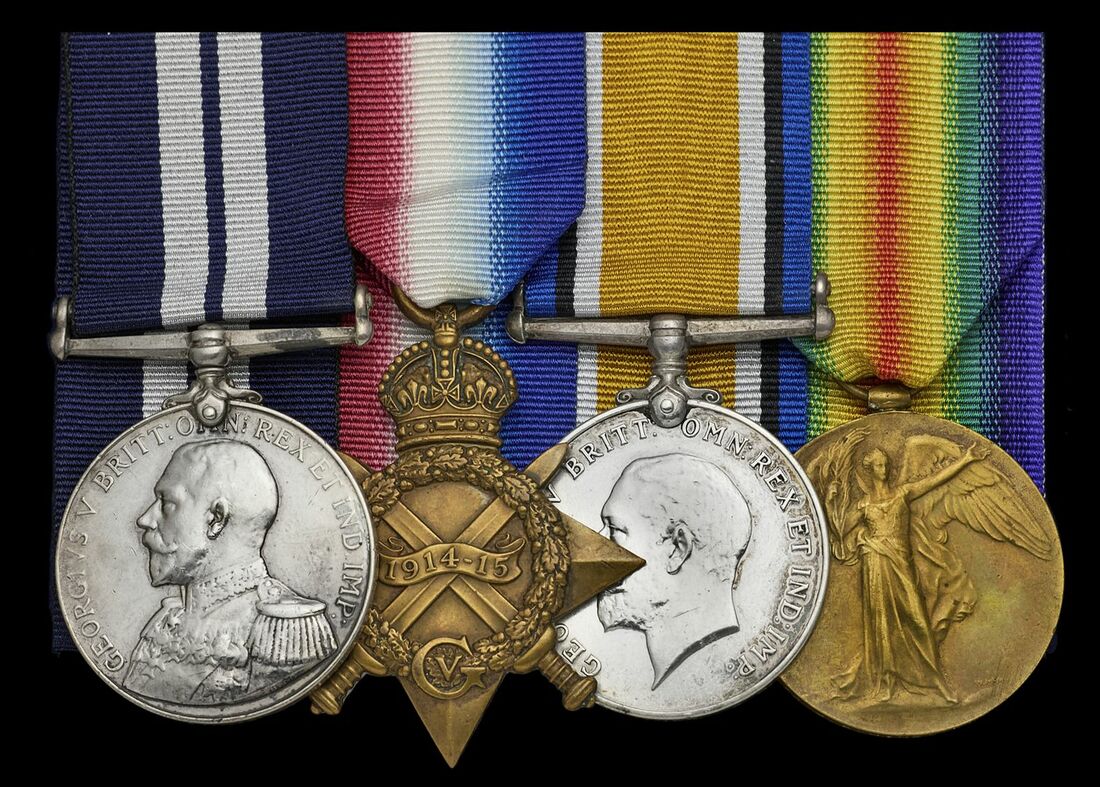
Auction: 24001 - Orders, Decorations and Medals
Lot: 127
The superb 'Jutland 1916' D.S.M. group of four awarded to Able Seaman J. E. Hines, Royal Navy, who stuck to his gun despite terrible wounds which saw the right half of his upper jaw shot away, a large gash opened in his chest and the tendon of his left wrist exposed
Distinguished Service Medal, G.V.R. (J.38370. J. E. Hines. A.B. H.M.S. Calliope. 31 May,-1 June, 1916); 1914-15 Star (J.38370, J. E. Hines, A.B., R.N.); British War and Victory Medals (J.38370 J. E. Hines. A.B. R.N.), sold together with original service papers and a wound certificate, the first somewhat polished, light contact wear to all, very fine (4)
D.S.M. London Gazette 15 September 1915, the original citation states:
'for services rendered by Petty Officers and men of the Grand Fleet in the action in the North Sea on the 31st May-1st June, 1916.'
James Edwin Hines was born at Southwark on 3 July 1896 and enlisted with the Royal Navy as Ordinary Seaman on 26 April 1915. He was soon posted to active duty with the destroyer Louis on 29 June 1915 from the depot ship Dido with the rank of Able Seaman.
The Dardanelles
She operated from the depot ship Blenheim, performing a support role in the Allied forces fighting for control of the Peninsula. As a result she was just off the coast during a major storm, late in the evening of 31 October 1915 and was driven onto the rocks of Suvla Bay. All attempts to free her proved pointless and her crew abandoned ship, the diary of the Major G. J. Gillam refers to what happened next, stating:
'The destroyer has now completely broken her back, and her stern has disappeared. The Turks discovered the mishap, but they could not see that she was a wreck, as she is bows on to the Turkish position. Thinking therefore that the was still intact, though stuck on the ground, they attempted to finish her off, and for three hours shelled her. They only recorded two hits however...'
Hines was posted ashore after the loss of Louis and it was some time before he found another posting, this being the light cruiser Calliope on 10 May 1916. She was stationed with the 4th Light Cruiser Squadron at that stage and less than a month later steamed out with Admiral Beatty's Battlecruiser fleet to take part in the Battle of Jutland.
Jutland
During the Run to the North Calliope and three other vessel from her squadron deployed to pursue a force of German destroyers. Unfortunately, they ran into three German Battleships of the 3rd Squadron and came under heavy fire. Zigzag wildley they returned fire against their far larger and better armed opponents while shells splashed down around them. Calliope found herself under the guns of the Kaiser and the Markgraf, sustaining five solid hits as she ran. One officer described the carnage stating:
'One shell, bursting against the breech of the port after 4-inch gun, smashed the fittings and gun shield and killed practically all the gun's crew, the notable exception being the sightsetter, a Corporal of the Marines, who had the gun between him and the burst and only suffered a slight scalp wound.
The second hit on us burst near No. 3 4-inch gun under the bridge, disabled the gun, killing and wounding some of the crew, and fragments of this shell penetrated the deck of the lower bridge and wounded a signalman and a bugler.
The third shell penetrated the upper deck, and burst in the boys' mess deck, almost in the middle of the after dressing station, killing some and wounding many others, including the Staff Surgeon.'
We cannot be sure of where Hines was stationed but it seems likely he was with the No. 3 gun This assertion is supported by an article on Hines, written in the Chelmsford Chronicle on 13 April 1917, which fleshes out the story from his perspective stating:
'He was on H.M.S. Calliope in the Jutland battle, and one of the crew of a gun which was hit by an enemy shell. He was severely injured in the face, but stuck to his duty as long as he could, and after being removed below to have his injuries attended to created a cheerful atmosphere by his sheer good spirit.'
This seems at odds with his wound certificate however, which makes from grim reading. Hines had suffered appalling harm with the right half of his upper jaw shot away completely. He was also peppered with splinters and burns, had a large gash on his chest and minor ones of his right leg as well as a gaping wound in his left wrist which exposed the tendon and injured his radial artery. Despite these wounds, which could well have killed a lesser man, he remained at his post and manned the gun until forced by his injuries to go below decks.
Survivor
Somewhat surprisingly Hines managed to survive his wounds and was posted ashore on 3 June 1916 at Pembroke I. From there he was quickly sent to President in London and remained there for the rest of the war. He was discharged via the Royal Naval Hospital at Chatham on 27 February 1919; sold together with copied medal rolls, former dealers listing and an extract from the Chelmsford Chronicle.
Subject to 20% VAT on Buyer’s Premium. For more information please view Terms and Conditions for Buyers.
Sold for
£1,800
Starting price
£1800




